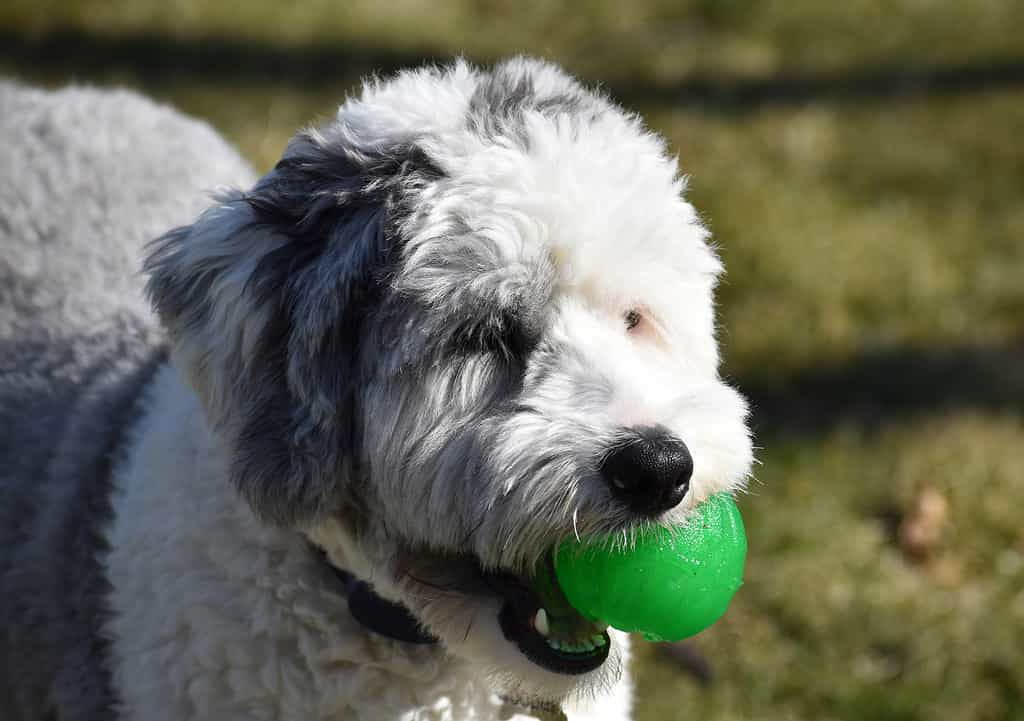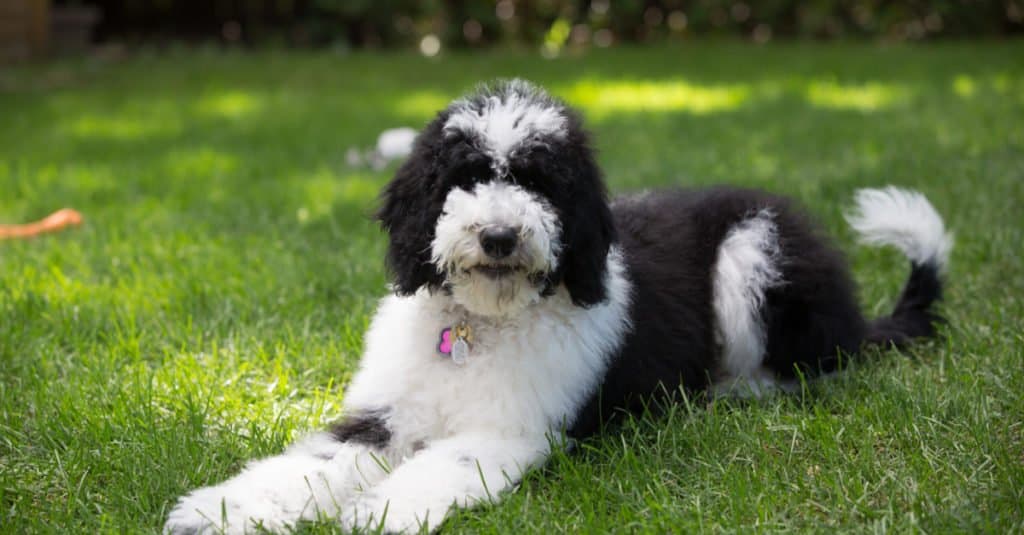Sheepadoodle Summary
The Sheepadoodle is an endearing hybrid that combines the best traits of the Old English sheepdog and the Poodle, resulting in a fluffy, intelligent, and friendly companion. Known for their playful nature and hypoallergenic coats, Sheepadoodles typically exhibit a gentle disposition that makes them excellent family pets. While their size can vary, depending on whether the Poodle parent is a standard or miniature, they generally range from medium to large dogs. They are known for being highly trainable due to their intelligence and eagerness to please, making them a great addition to active households looking for a sociable and loving dog.
Sheepadoodle Growth and Weight Chart by Age
| Age | Mini Male and Female Sheepadoodle Weight | Medium Sheepadoodle Male and Female Weight | Standard Male and Female Sheepadoodle Weight |
|---|---|---|---|
| Birth | 1-2 lbs | 2-4 lbs | 3-5 lbs |
| 1 Month | 4-8 lbs | 8-15 lbs | 10-20 lbs |
| 2 Months | 7-15 lbs | 15-25 lbs | 20-35 lbs |
| 3 Months | 10-20 lbs | 20-35 lbs | 30-50 lbs |
| 4 Months | 15-25 lbs | 25-40 lbs | 40-60 lbs |
| 5 Months | 18-30 lbs | 30-45 lbs | 50-65 lbs |
| 6 Months | 20-35 lbs | 35-50 lbs | 55-70 lbs |
| 7 Months | 22-38 lbs | 38-52 lbs | 60-75 lbs |
| 8 Months | 23-40 lbs | 40-53 lbs | 62-78 lbs |
| 9 Months | 23-42 lbs | 40-54 lbs | 63-80 lbs |
| 10 Months | 24-43 lbs | 40-55 lbs | 64-80 lbs |
| 11 Months | 24-44 lbs | 40-55 lbs | 65-80 lbs |
| 12 Months | 25-45 lbs | 40-55 lbs | 55-80 lbs |
| 2 Years | 25-45 lbs | 40-55 lbs | 55-80 lbs |
When Will My Sheepadoodle Stop Growing?
Sheepadoodles usually reach their full size by the time they are 18 months old, with the most significant growth occurring before their first birthday.
Diet and Nutrition
Feeding your Sheepadoodle the correct amount of high-quality dog food tailored for large breeds is essential. Adult Sheepadoodles typically require 3 to 4 cups of food daily, divided into two or three meals to facilitate proper digestion and prevent overeating. Avoid free feeding to mitigate the risk of obesity.
For puppies, a nutrient-dense diet with appropriately sized portions is key. Feed them four times a day until six months old, then you can reduce the frequency to two or three meals daily as they transition into adulthood.
Veterinary Care and Monitoring
Regular veterinary check-ups are critical to ensure your Sheepadoodle is growing at a healthy rate. Puppies should visit the vet several times during their first year for vaccinations and growth assessments. As they grow older, annual health checks are recommended, although any health concerns may necessitate more frequent visits.
Parental Genetics
The size of a Sheepadoodle is heavily influenced by the size of its parents. Since Sheepadoodles are a hybrid of the Sheepdog and Poodle breeds, they inherit traits from both. Given the three distinct sizes of Poodles, Toy, Miniature, and Standard the size of a Sheepadoodle can vary significantly. This genetic lottery means that the resulting sheepadoodle can be classified into Toy, Medium, or Standard sizes, correlating with the size of the Poodle parent.
Generational Influence
The term “generation” refers to the specific lineage of a Sheepadoodle. An F1 Sheepadoodle is a first-generation crossbreed between a purebred Poodle and an Old English sheepdog. An F1B represents a backcross in which an F1 Sheepadoodle is bred back to a Poodle, potentially introducing more Poodle traits such as low shedding. As breeders continue to breed sheepadoodles, they may aim for smaller sizes by introducing smaller Poodles into the lineage, as is the case when aiming for a ‘Micro Mini Sheepdoodle.’ The specific generational cross can greatly affect the size, appearance, and characteristics of a Sheepadoodle.
How Big Will My Sheepadoodle Be When It’s Fully Grown?
Male Sheepadoodles, belonging to a large breed category, typically stand between 13 and 24 inches in height and tip the scales at about 60 to 80 pounds. Female counterparts usually share the same height range of 13 to 24 inches but tend to be lighter, weighing in between 45 and 65 pounds. These wide ranges acknowledge the considerable variation in size that Sheepadoodles exhibit, stemming from the unique genetic combinations they may inherit from their Old English sheepdog and Poodle parents.
When Should My Sheepadoodle Be Spayed or Neutered?
For male Sheepadoodles, the typical recommendation for neutering is around six to nine months of age. However, because Sheepadoodles can be a larger breed, some veterinarians may advise waiting until they are a bit older, potentially up to a year, especially if they have not yet reached their full size. This delay can sometimes benefit their physical development.
For female Sheepadoodles, spaying is usually recommended before their first heat, which can occur as early as six months of age. Some experts suggest spaying before maturity can reduce the risk of certain cancers and uterine infections. However, for larger breeds like Sheepadoodles, your vet may recommend waiting until they are a bit older, possibly between nine to fifteen months. This can ensure they have fully benefited from the growth and developmental advantages of their hormones while minimizing the risk of future health issues.
It’s essential to have a conversation with your veterinarian about the optimal timing for spaying or neutering your pet, as they will consider the individual growth, breed characteristics, and overall health of your Sheepadoodle to provide the best recommendation.
When Should My Sheepadoodle Be House Broken?
Sheepadoodles, with their unique combination of the Old English sheepdog and Poodle lineage, are typically quite receptive to house training. Typically, the process of potty training a Sheepadoodle, or any puppy, can begin in earnest once they are around 8 to 10 weeks old.
Here are some tips for house training your Sheepadoodle:
- Establish a Routine: Dogs, by their nature, like routine. Set a consistent schedule for feeding, potty breaks, playtime, and sleep. Generally, a puppy can control their bladder one hour for every month of age. So, an 8-week-old puppy would need to go outside at least every two hours.
- Frequent Breaks: Take them out first thing in the morning, after every meal, after naps, and before bedtime. Young puppies generally need to be taken outside frequently, more than adult dogs, to avoid accidents.
- Choose a Potty Spot: Lead your Sheepadoodle to a specific area to do their business. Their scent will remind them what to do in that spot.
- Positive Reinforcement: Always reward with praise and a treat immediately after your puppy eliminates outside. This positive reinforcement will encourage them to repeat the desired behavior.
- Handle Accidents Gracefully: If your puppy has an accident, calmly clean it up without punishment. Use an enzymatic cleaner to eliminate the odor and discourage them from marking the same spot.
- Monitor Diet and Water Intake: Manage your puppy’s diet and water consumption. What goes into a puppy on a schedule comes out of a puppy on a schedule.
When Should My Sheepadoodle Stop Eating Puppy Food?
Transitioning your dog from puppy food to adult food is an important milestone that requires careful timing to ensure their continued health and proper growth. For Sheepadoodles, which are a mixed breed, the shift from puppy-specific formulas to adult dog food usually happens when they’re nearing their adult size, typically at about 12 to 18 months old.
Nutritional Differences Between Puppy and Adult Dog Food
Puppy food is formulated with a rich blend of nutrients, such as elevated levels of protein, fats, vitamins, and minerals, to cater to a young dog’s rapid development. Adult dog food, by contrast, is designed to maintain health after growth has decelerated, with nutritional content tailored for ongoing maintenance rather than growth.
Risks of Transitioning Too Early or Too Late
Switching your Sheepadoodle to adult food prematurely can lead to nutrient shortages, which may affect their bone and joint health. This is especially critical for larger breeds prone to growth-related disorders. If they remain on puppy food beyond the appropriate age, the excessive calories and certain nutrients like calcium could contribute to obesity and orthopedic issues.
How to Transition Properly
The changeover from puppy to adult food should be done gradually over about a week to ten days, introducing the adult food incrementally to avoid digestive troubles. When choosing an adult dog food, prioritize products that align with your Sheepadoodles size, activity level, and life stage. A high-quality adult dog food will often have meat as its primary ingredient and be free from by-products, artificial colors, or preservatives.
Consulting Your Veterinarian
It’s essential to discuss any dietary changes with your vet. They can offer personalized advice based on your Sheepadoodles health, size, and nutritional requirements, ensuring a smooth and healthy transition to adult food.
Teething Timeline for Sheepadoodles
Sheepadoodles generally begin to lose their puppy teeth and grow in their adult teeth around three to four months of age. This process will continue until they are about six months old. Given their mixed heritage, the timing might slightly differ based on the dominant genes inherited from the parent breeds.
Recognizing Teething Signs in Sheepadoodles
Look out for telltale signs that your Sheepadoodle puppy is teething:
- Increased chewing and biting urges
- Drooling more than usual
- Red or swollen gums
- Slight bleeding from the gums
- Possible loss of appetite or difficulty eating
- Occasional irritability or discomfort
Managing Your Sheepadoodles Teething Comfort
To help your Sheepadoodle puppy cope with teething discomfort:
- Chew Toys: Supply a variety of chew toys. Sheepadoodles are often quite playful and energetic, and having durable chew toys can provide great relief.
- Cold Treats: Offer frozen carrots or special puppy teething rings that can soothe their sore gums.
- Dental Health: Start a dental hygiene routine early. Gently brushing their teeth can help them get used to the sensation and maintain dental health.
- Professional Checkups: Ensure you stick to the puppy checkup schedule with your veterinarian to monitor their dental health.
Potential Sheepadoodle-Specific Considerations
With their Poodle heritage, Sheepadoodles may be predisposed to certain dental issues such as plaque buildup due to the Poodle’s characteristic tightly-packed teeth. Regular dental check-ups and cleanings are even more crucial for preventing long-term issues.
When Should I Start Training My Sheepadoodle?
Training a Sheepadoodle requires consistency, patience, and an understanding of the breed’s characteristics. Here are some training tips tailored for your Sheepadoodle:
Basic Manners
Since Sheepadoodles tend to grow into large, sturdy dogs, teaching them basic manners is crucial:
- Leash Training: Begin leash training early. A Sheepadoodle should learn to walk calmly by your side without pulling. Harnesses can be a good tool, especially during the initial stages of training.
- Polite Greetings: Teach your Sheepadoodle to greet people calmly. This prevents jumping up on guests and can be achieved through positive reinforcement techniques.
- Recall: Training your dog to come when called is vital for their safety. Practice this skill in a variety of environments with increasing levels of distraction.
Socialization
Proper socialization is key for a well-adjusted Sheepadoodle:
- Positive Experiences: Introduce your Sheepadoodle puppy to different people, dogs, and environments. Ensure each new experience is positive and not overwhelming.
- Dog-Friendly Outings: Taking your Sheepadoodle to dog-friendly public spaces can help with socialization. Make sure he’s comfortable and not forced into interactions.
- Group Classes: Consider enrolling in group training classes. This will not only help with basic commands but also with social skills.
Respecting Boundaries
Understanding a Sheepadoodles comfort with strangers:
- Let Them Choose: Allow your Sheepadoodle to approach new people in their own time. Encourage guests to allow your puppy to come to them rather than the other way around.
- Body Language: Pay attention to your dog’s body language. It tells you a lot about how they’re feeling and whether they’re comfortable or stressed.
Behavioral Training
Keep in mind these breed-specific training considerations:
- Intelligence and Energy: Sheepadoodles are typically intelligent and energetic. They need mental stimulation as well as physical exercise, or they may find their own (often destructive) ways to alleviate boredom.
- Consistency: Due to their smart nature, Sheepadoodles can be quite adept at pushing boundaries. Consistency in training is key to ensure they understand the rules.
Training Techniques Positive reinforcement works best:
- Rewards-Based Training: Reward desirable behavior with treats, praise, or playtime.
- Avoid Punishment: Negative or punishment-based techniques can harm the trust between you and your dog. Stick to positive methods for the best results
What Cues Should I Teach My Sheepadoodle First?
Training your Sheepadoodle should start with some foundational cues that will serve as building blocks for more advanced training. Positive reinforcement is indeed the most effective and kind way to train any dog, rewarding them for good behavior so that they are more likely to repeat it. Here are some essential cues to start with:
- Sit: This basic command is useful to calm your dog and is a foundation for other behaviors.
- Stay: Teaches your dog self-control and patience, and can keep them safe.
- Come: Perhaps the most crucial for safety, it ensures your dog returns to you when called.
- Down: Helps in situations where you need your dog to lie down and stay put.
- Leave It: Essential for preventing your dog from picking up dangerous or unwanted items.
- No: A clear and gentle way to communicate that a behavior is unacceptable.
- Heel: Keeps your dog walking by your side, useful for managing walking behavior.
- Off: Teaches your dog to get down from furniture or to not jump on people.
- Drop It: Important for them to release something from their mouth on command.
Starting with these cues and consistently practicing them will set a strong foundation for your Sheepadoodles obedience. Remember, short, frequent training sessions with lots of praise and treats work best.
When Will My Sheepadoodle Calm Down?
Sheepadoodles are known for their energetic and playful nature, typically beginning to calm down as they transition out of puppyhood, usually around the age of two to three years. This timeline can be influenced by individual temperament, training, exercise routines, and overall lifestyle. Implementing consistent training, providing ample exercise, and ensuring proper mental stimulation through interactive play and obedience challenges are crucial for managing their lively demeanor. Engaging in socialization activities and establishing a regular routine can also promote a sense of security and calm. As they grow, reinforcing calm behavior with positive reinforcement will encourage your Sheepadoodle to adopt a more relaxed personality.
Common Health Issues Your Sheepadoodle Might Experience
Your Sheepadoodle could potentially face some health challenges common to both of its parent breeds, the Old English Sheepdog and the Poodle. Being aware of these potential issues allows for proactive care and management. Here’s what to look out for.
- Joint Problems: Hip and elbow dysplasia, along with patellar luxation, are conditions that may affect Sheepadoodles. These issues involve the malformation or misalignment of joints, which can cause pain and affect mobility.
- Digestive Issues: Sheepadoodles may inherit a tendency towards food sensitivities and digestive issues. Bloat, or gastric torsion, is particularly concerning and requires immediate veterinary attention as it can be life-threatening.
- Skin Conditions: Skin sensitivities and allergies can lead to various dermatological issues. Regular grooming and a diet tailored to sensitive skin can help manage these problems.
- Eye Diseases: Keep an eye out for signs of eye problems such as progressive retinal atrophy (PRA), cataracts, and entropion, which can impact vision.
- Ear Infections: Due to their floppy ears, Sheepadoodles can be prone to ear infections. Regular cleaning and monitoring are key to preventing these.
- Heart Conditions: Like many breeds, they may be susceptible to certain cardiac conditions. Regular check-ups can help catch any heart-related issues early.
- Addison’s Disease: This endocrine disorder, where the body doesn’t produce enough steroid hormones, can be managed with medication once diagnosed.
- Cushing’s Disease: Another endocrine condition that can affect your Sheepadoodle is Cushing’s disease, characterized by an overproduction of cortisol, which can be identified through symptoms and confirmed with veterinary tests
A Picture Of A Sheepadoodle As A Puppy

A Sheepadoodle puppy.
©Logan Swenson/iStock via Getty Images
A Picture Of A Sheepadoodle At 6 Months

A six-month-old Sheepadoodle puppy.
©Logan Swenson/iStock via Getty Images
A Picture Of A Full Grown Sheepadoodle

An adult Sheepadoodle.
©Lisa Mounteer/Shutterstock.com
The photo featured at the top of this post is © Wirestock/iStock via Getty Images
Ready to discover the top 10 cutest dog breeds in the entire world?
How about the fastest dogs, the largest dogs and those that are -- quite frankly -- just the kindest dogs on the planet? Each day, AZ Animals sends out lists just like this to our thousands of email subscribers. And the best part? It's FREE. Join today by entering your email below.
Thank you for reading! Have some feedback for us? Contact the AZ Animals editorial team.







